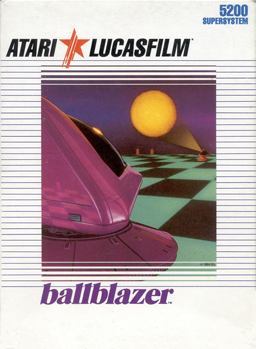Ballblazer
| Ballblazer | |
|---|---|
 |
|
| Developer(s) | Lucasfilm Games |
| Publisher(s) |
Atari Epyx Activision |
| Director(s) | David Levine |
| Designer(s) | David Levine Peter Langston David Riordan Garry Hare |
| Platform(s) | Atari 8-bit, Amstrad CPC, Apple II, Atari 5200, Commodore 64, MSX, ZX Spectrum, Atari 7800, Famicom |
| Release | March 1984 |
| Genre(s) | Sports, Action |
| Mode(s) | Single player, Two player |
Ballblazer is a 1984 futuristic sports game created by Lucasfilm Games. It was originally released for the Atari 8-bit family, then ported to the Atari 5200, Apple II, ZX Spectrum, Amstrad CPC, Commodore 64, MSX. and later the Atari 7800 and the Nintendo Famicom. The game was called Ballblaster during development; pirated versions of the game went by this name as well. The principal creator and programmer of Ballblazer was David Levine.
In 1990, LucasArts and Rainbow Arts released a remake and follow-up to this game, called Masterblazer. This game was released for the Amiga, Atari ST, and MS-DOS. On March 31, 1997, a remake of the original titled Ballblazer Champions was released for the Sony PlayStation.
Ballblazer is a simple one-on-one sports-style game bearing similarities to basketball and soccer. Each side is represented by a craft called a "rotofoil", which can be controlled by either a human player or a computer-controlled "droid" with ten levels of difficulty. (The game allows for human vs. human, human vs. droid, and droid vs. droid matches.) The basic objective of the game is to score points by either firing or carrying a floating ball into the opponent's goal. The game takes place on a flat, checkerboard playfield, and each player's half of the screen is presented in a first-person perspective.
A player can gain possession of the ball by simply running into it, at which point it is held in a force field in front of the craft. The opponent can attempt to knock the ball away from the player using the fire button, and the player in possession of the ball can also fire the ball toward the goal. When a player does not have possession of the ball, his or her rotofoil automatically turns at 90-degree intervals to face the ball, while possessing the ball turns the player toward the opponent's goal. The goalposts move from side to side at each end of the playfield, and as goals are scored, the goal becomes narrower.
...
Wikipedia
